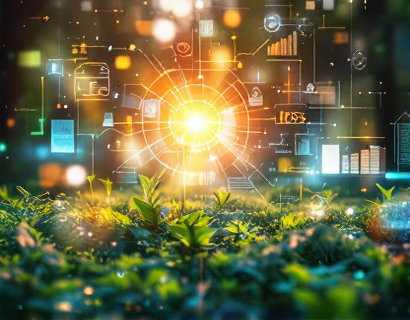Optimizing Horticulture and Farming with Advanced Environmental Analytics for Sustainable Growth
In the quest for sustainable growth in horticulture and farming, the integration of advanced environmental analytics stands out as a transformative approach. This method leverages cutting-edge technology to optimize resource management and enhance crop yields, ultimately contributing to a healthier planet. By harnessing data-driven insights, farmers and horticulturists can make informed decisions that not only boost productivity but also ensure environmental stewardship.
Understanding Environmental Analytics in Agriculture
Environmental analytics in the context of agriculture involves the collection, analysis, and interpretation of environmental data to inform decision-making processes. This data can include a wide range of variables such as soil moisture levels, temperature, humidity, light intensity, and nutrient content. By monitoring these factors in real-time, farmers can adjust their practices to optimize growing conditions for their crops.
Key Components of Environmental Analytics
- Soil Moisture Monitoring: Accurate measurement of soil moisture levels is crucial for efficient irrigation. Advanced sensors can provide real-time data, allowing farmers to irrigate only when necessary, thus conserving water and preventing over-saturation.
- Weather Forecasting: Integrating weather data into farm management systems helps predict and prepare for adverse conditions. This can include adjusting planting schedules, applying protective measures, or optimizing harvesting times.
- Nutrient Management: Analyzing soil nutrient levels enables precise application of fertilizers, reducing waste and minimizing environmental impact. This data-driven approach ensures that crops receive the exact nutrients they need, when they need them.
- Pest and Disease Detection: Advanced sensors and imaging technologies can detect early signs of pest infestations or diseases, allowing for timely intervention and reducing the need for broad-spectrum pesticides.
Benefits of Advanced Environmental Analytics
The implementation of environmental analytics in horticulture and farming offers numerous benefits. Firstly, it leads to more efficient use of resources, particularly water and fertilizers, which are often limited and costly. By applying these resources only where and when they are needed, farmers can significantly reduce costs and environmental footprint.
Secondly, data-driven insights enable precision agriculture, where management practices are tailored to the specific needs of different areas within a field. This approach maximizes crop yields while minimizing waste and environmental impact. For instance, variable rate technology can adjust the amount of fertilizer or water applied based on real-time soil conditions, ensuring optimal growth without overuse of resources.
Thirdly, environmental analytics contribute to sustainable farming practices by promoting soil health and biodiversity. By avoiding over-irrigation and excessive fertilizer use, farmers can prevent soil degradation and maintain the natural balance of ecosystems. This not only benefits the environment but also ensures long-term productivity and resilience of agricultural systems.
Case Studies and Real-World Applications
Several case studies demonstrate the positive impact of environmental analytics on horticulture and farming. In one example, a vineyard in a water-scarce region implemented a soil moisture monitoring system. The data collected allowed the vineyard to reduce water usage by 30% while maintaining or even increasing grape quality. This not only saved on water costs but also reduced the environmental strain of excessive irrigation.
Another instance involves a vegetable farm that adopted precision nutrient management based on soil testing data. By applying fertilizers only where needed and in the right quantities, the farm reduced its fertilizer costs by 25% and significantly lowered nutrient runoff into nearby water bodies. This approach not only improved profitability but also enhanced the farm's environmental credentials.
Challenges and Considerations
While the benefits of environmental analytics are clear, there are challenges and considerations that farmers and horticulturists must address. One major challenge is the initial investment in technology and infrastructure. Advanced sensors, data collection systems, and software can be costly, particularly for small-scale operations. However, the long-term savings and increased efficiency often justify the upfront costs.
Another consideration is the need for technical expertise to effectively use and interpret the data. Farmers may require training or assistance to fully leverage the capabilities of environmental analytics tools. Collaboration with agricultural extension services or technology providers can help bridge this gap, providing support and education to users.
Data privacy and security are also important concerns. Ensuring that sensitive farm data is protected from unauthorized access is crucial. Reputable providers of environmental analytics solutions implement robust security measures to safeguard user data, providing peace of mind for adopters.
Future Trends and Innovations
The field of environmental analytics in agriculture is rapidly evolving, with several promising trends on the horizon. One such trend is the integration of artificial intelligence and machine learning to enhance data analysis and decision-making. AI can process vast amounts of data to identify patterns and predict outcomes, further optimizing farm operations.
Another area of innovation is the development of more affordable and accessible technologies. As the demand for sustainable agriculture grows, we can expect to see more budget-friendly solutions that provide valuable insights without the high cost barrier. This democratization of technology will enable more farmers, regardless of size, to benefit from advanced environmental analytics.
Additionally, the convergence of IoT (Internet of Things) devices and environmental analytics is set to revolutionize farm management. Smart sensors and connected devices can automate many processes, from irrigation to pest control, creating a more efficient and responsive agricultural system.
Conclusion
Advanced environmental analytics offer a powerful tool for optimizing horticulture and farming practices, leading to sustainable growth and enhanced productivity. By leveraging real-time data and data-driven insights, farmers and horticulturists can make informed decisions that benefit both their operations and the environment. As technology continues to advance and become more accessible, the potential for positive impact in agriculture is immense. Embracing these innovations is not just a choice for the future; it is a necessity for ensuring the health and sustainability of our planet.










































